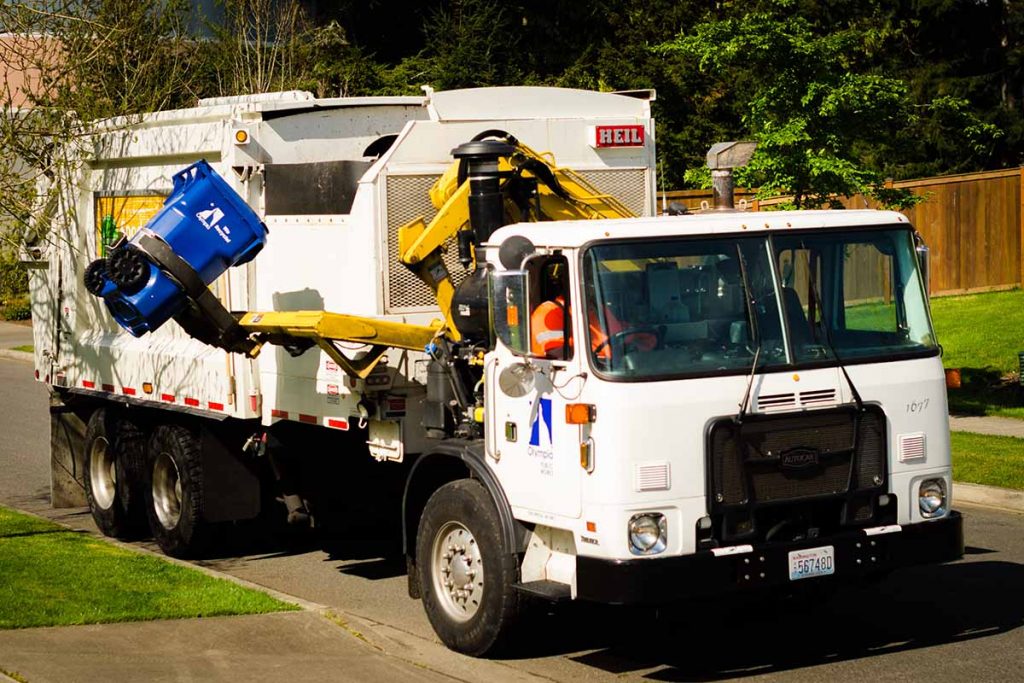
In Olympia, Wash. program officials have worked to bring the local recycling contamination rate below 8%. | Courtesy of city of Olympia, Wash.
Grand Rapids, Mich. and Olympia, Wash. were honored for their recent work significantly limiting contamination and boosting their residential recycling programs in other ways.
The winners of the 2021 Program of the Year awards from Resource Recycling were announced today during the closing session of the Resource Recycling Conference, which ran Aug. 4-5 and was held entirely online.
Grand Rapids picked up the prize in the Large City category, which was open to municipalities with 150,000 residents or more. Olympia won in the Small City category (fewer than 150,000 residents).
Contamination abatement has been central to recent recycling success in each city. In its submission materials to the awards program, Grand Rapids reported a contamination rate of 7.4%, and Olympia reported a 7.5% contamination number.
Both percentages are far lower than what’s being seen in many local programs in the U.S., where contamination rates above 20% are common. (The metric describes the percentage of material put in recycling by residents that can not actually be moved to downstream markets.)
During an Aug. 5 session announcing the winners, Ron Jones, a senior planner representing the city of Olympia, said his municipal program drew on many existing resources in getting to its current diversion success.
“We don’t do it in a vacuum, we do it by learning from all the others just like we are doing today,” Jones said.
Inaugural edition of awards program
This year marks the first time Resource Recycling has offered Program of the Year awards.
An open submission process in late spring and early summer of 2021 yielded candidates from across the country. Submissions were reviewed by the Resource Recycling editorial staff, and winners were selected with input from a committee of municipal recycling experts representing industry groups and consultancies.
In both Grand Rapids and Olympia, city crews collect curbside recycling. In Grand Rapids, 7,170 tons were collected from over 50,500 households in the most recent program year. In Olympia, 4,500 tons of recyclables were collected from around 24,000 households.
Olympia has seen contamination greatly reduced in recent years thanks to a “lid lift” program. To start the initiative, the city of 52,000 residents worked with college interns specializing in geographic information systems (GIS) to design a system that would allow the city to run a small scale pilot in various neighborhoods and measure success.
The program involved choosing neighborhoods, measuring contamination through recycle sorts to establish a baseline, and then leaving feedback with customers via cart tags during spot checks.
That effort, which launched in the summer of 2019, helped reduce Olympia’s contamination from the 15-20% range to 7-10%.
Jones noted that a successful cart tagging program takes a lot of effort and involvement.
“It takes time to go cart to cart, door to door,” Jones said. “And you have to be there before the truck arrives to dump the cart. You can only do so many in a day.”
He added it’s critical to really examine the type of cart tag a program will employ, as well as how it communicates recycling instructions. It’s particularly important to consider the target community.
“Those cultural differences, the equity and inclusion piece, and being able to reach different audience members – I think that might be the place to start,” Jones said. “So when you are communicating, you are communicating in the best way possible.”
Coordinating with the MRF
Meanwhile, in Grand Rapids, which has a population of 198,000, program leaders have recently worked closely with the nearby Kent County materials recovery facility (MRF) to educate residents and enforce strict anti-contamination controls.
City crews remove carts after high levels of trash are found in recycling at a residence three times. Residents must wait six months and go through a “Recycling 101” training class with the MRF to get their carts back.
Grand Rapids also implemented a “Feet on the Street” anti-contamination tagging program in the fall of 2020, inspecting recycling set-outs at all 50,540 serviced households over the course of eight weeks. That effort reduced contamination in the local recycling stream by 37%, according to program leaders.
Robert Swain, solid waste programs manager for the city of Grand Rapids, described the city’s recycling program evolution. The city moved from dual- to single-stream recycling in 2010 and saw increasing recycling rates in the subsequent years.
In 2017, the city saw diversion rates dropping. The municipal program noticed the curbside program was generating “highly contaminated loads we couldn’t take to the MRF,” Swain said.
“We started looking more into that and knew we had to come up with a solution to the contamination rate,” Swain said. The city ended up applying for a grant through The Recycling Partnership for the cart tagging program, and Grand Rapids rolled that program out to its residents.
Swain said the cart-tagging program did “exactly what it was supposed to do,” and said for any community looking into that type of program, “it really does work.” The program ended a few months ago, and Swain said the city is looking into its next steps for continuing to keep contamination down.
“Right now, we’re trying to figure out how to sustain all those achievements we made,” Swain said.